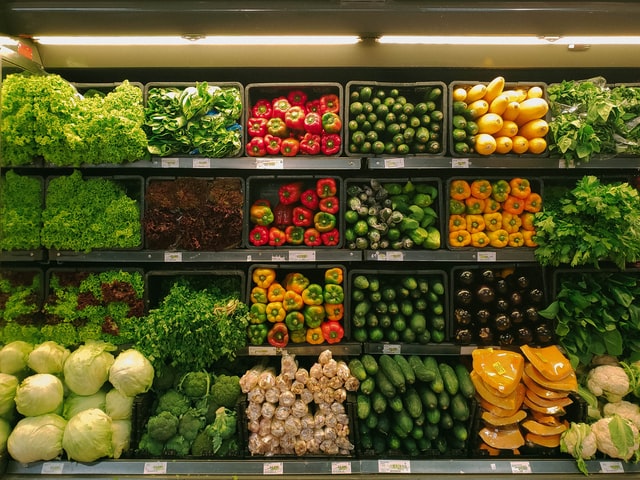$100 to grocery shop for 7 days for a family of 4 (or, you know, two athletes?)? Yes, it can be done! Whether your budget is tighter because of inflation or you’re just trying to save some extra cash, we have you covered on how you can eat healthy while saving money. We asked past podcast guests Kylee Van Horn, runner and RD and pro cyclist Lori Nedescu, RD, CSSD to add some tips here as well, and we’re really psyched about what they said.
As we were writing our book, Becoming A Consummate Athlete, we realized that a lot of people equate healthy eating with being expensive and out of their range. But really, we’ve found the opposite can be true. Sure, it takes a bit more work, and yes, you absolutely can end up with a HUGE grocery bill in the name of ‘health,’ but it’s totally do-able to stay on the lower side of grocery spending and stay happy. (In our book, we have grocery lists that can be modified to be budget-friendly, plus an awesome food chart that helps you design healthy meals at any price point)
But in the meantime, here’s what you need to know.
Prep for food boredom
Eating on a budget isn’t super sexy, we’ll be honest. You’ll likely end up with a rotation of the same few meals, in order to avoid wasting ingredients, and certain foods like oatmeal and rice lend themselves to cheap eating over things like quinoa and bakery bread. But that doesn’t have to be a bad thing! Your food choices may be consistent, but they can also be delicious. And you CAN use spices and sauces, especially those that are in your pantry already, to shake up flavors and make the same ingredients feel new.
Don’t go to the fancy grocery stores; you can find everything you need at your mid-level chain store, Lori says. This is a big one for those who frequent Whole Foods! (Or if you do love Whole Foods, go there for your must-haves but shop the cheaper places for the staples that are the same store to store.)
Be prepared to put in a little work to make this happen, Kylee says. That means you should look for sales, look up new recipes, make a shopping list, and start utilizing things that have been collecting dust in your pantry.
Buy:
Funny enough, both RDs shared the same top 6 grocery staples:
- Dried Beans
- Brown Rice
- Frozen Vegetables and Fruit
- Oats
- Eggs
- Peanut Butter
Frozen over fresh
That’s right: Choose frozen over fresh fruits and vegetables. They are flash frozen at peak ripeness anyway and just as healthy if not more healthy! They’re cheaper, and won’t go bad. They can go into stir fries and stews, be side dishes or main courses, and if you buy the sale options each week, you’ll get tons of variety in your veggies.
Buy in bulk if you can
Especially on non-perishables that last a while, or starches like potatoes. But be smart about it, don’t go overboard with your buys here. If you’ve never used dried beans before, start smaller.
Buy seasonally
Look for the sales and lowered prices in produce, since that’s usually an indication that something is locally in season. For instance, in Ontario right now, squash and sweet potatoes are super cheap, so we’re cooking a lot more with squash! The more you stick to this rule, the more you start realizing how the prices fluctuate month after month.
Decide what is important to you
For us, that was a high-quality meat, and while it’s a big spend upfront and requires some creative storage, we get half a cow every year from a local farmer. Ultimately, the price per pound is much lower than even the cheap meat at the store, and we’re much happier with the quality anyway.
What Not to Buy
What you skip is as important—or more important—than what you actually do buy, since it’s not just about buying cheap, it’s about not spending money on non-essentials. On Lori’s ‘don’t buy’ list:
- Most convenience options like protein bars, granola, etc. (you can make your own granola at home easily with oats and a few ingredients—and it will likely be less sugar-heavy as a bonus!)
- Brand-name when store brand is equally good, for things like rice, canned goods, etc.
- Specialty products: for example, rice, quinoa, etc are cheaper and fine options vs gluten-free bread, for instance
- All organic: you can look at the Dirty Dozen list (by the environmental working group) if you want to choose which things to buy organic
Other Hacks
Most of the time, not wasting money is a balancing act of getting creative in the kitchen while not wasting any food.
- Learn how to store produce properly so that it doesn’t spoil and you reduce waste. At the end of each week, consider doing a kitchen sink soup with all of your leftover veggies, and make something tasty with any wilting fruit (apple crumble, banana bread, tarts, etc.)
- OK, I’m making a whole tip about stews because I freaking love them: Get a slow-cooker if you don’t have one already (they’re as low as $25 for a basic one!), and use that to make a simple stew with frozen veggies + protein of choice + canned diced tomatoes + a bullion cube or other spices a couple nights a week. Super healthy, and super inexpensive, especially if you use dried beans as your protein.
- Spend a little bit more to get all of the ingredients for basic baking (*not* fancy baking). If you figure out how many loaves you’ll be getting out of all of the ingredients, it is definitely a money saver, Kylee says. You can easily make bread, pizza crusts, cookies, and pretty much any baked good you want rather than buying them from the store. (My easy sourdough recipe is here and literally is just flour and water.)
- Always ask yourself ‘can I make this at home for less / healthier’ when it comes to processed foods that you usually would buy. That means trying to DIY things like salad dressing, granola, etc. — and we have a great recipe for a protein-packed salad dressing right here!
http://ConsummateAthlete.com/5-easy-foolproof-ways-to-make-sweet-potatoes/





